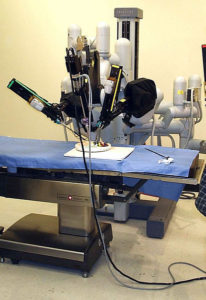As women age, the organs within the pelvis often move around and descend from their original positions. This can cause problems with the structure of the vagina. If this condition (pelvic organ prolapse) is severe enough, surgery may be required.

What is it?
Pelvic organ prolapse (POP) refers to the progressive descent of the bladder, vagina, uterus, and/or rectum through the pelvis. POP is relatively common and its prevalence increases with age. Surgery is not always required, but POP can be especially painful in some patients. A robotic sacrocolpopexy aims to correct the displacement of the pelvic organs by repositioning organs and adding artificial support. Surgeons are able to use robotic tools to make this procedure less painful for patients, shorten hospital stays, and increase the precision of the surgery.
How to Prepare
Patients will likely be under general anesthesia for the surgery. Doctors may recommend not eating or drinking after midnight before the surgery. Patients should stop smoking weeks before the procedure and should maintain a healthy diet supplemented with vitamins and minerals. Patients may experience pain weeks after the surgery, so physical therapy is often recommended as a way of relieving pain and increasing strength. Patients should prepare home and work spaces before the surgery as mobility may be limited for several weeks.
What happens during the process?
During a robotic sacrocolpopexy, the surgeon will operate laparoscopic tools in order to reposition and add support to the pelvic organs. The overall goal of the surgery is to restore the function and anatomy of the vagina and adjacent organs. This can be done in a few different ways, but typically a synthetic mesh is used to give support to the vagina. After the pelvic organs have been repositioned and secured, the tools are removed and the surgical incisions are closed.
Risks and Complications
- Deep vein thrombosis or pulmonary embolism
- Nerve damage
- Excessive bleeding or infection
- Damage to pelvic organs
Disclaimer:
All GlobeHealer Site content, including graphics, images, logos, and text, among other materials on the site are for educational purposes only. This content is not intended to be a substitute for professional medical advice, and you should always contact your physician or qualified health provider for information regarding your health. Information on this site regarding the overview, diagnosis, and treatment of any kind should be looked at, in addition to the advice and information of your health care professional. Do not disregard medical advice or delay seeking treatment or medical advice due to information found on the GlobeHealer site.
If there is even the possibility that you may have a medical emergency, seek treatment, call your doctor, or call your local emergency telephone number immediately. GlobeHealer does not endorse being the first line of communication in case of emergency and does not endorse any specific test, physician, facility, product, procedure, opinion, or other information that is or may be mentioned on this site or affiliated entities. Reliance of any and all information provided by GlobeHealer, its employees, affiliations, others appearing on the Site under the invitation of GlobeHealer, or visitors of the site is solely at your own risk and is not the responsibility of GlobeHealer.
Image Source:
https://commons.wikimedia.org/wiki/File:Laproscopic_Surgery_Robot.jpg
